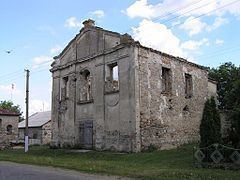Established 1692 Local time Thursday 3:16 PM | Area 1,541 km² | |
 | ||
Weather 14°C, Wind NE at 10 km/h, 74% Humidity | ||
Okopy (Ukrainian: Окопи) is a village (selo) in western Ukraine. It is located in the Borshchiv Raion (district) of the Ternopil Oblast (province), and had its origins as a Polish fortress at the meeting of the Zbruch and Dniester rivers.
Contents
Map of Okopy, Ternopil Oblast, Ukraine
The current estimated population is around 557 (as of 2005).
Name
The settlement was previously referred to as Okopy Svyatoyi Triytsi (Polish: Okopy Świętej Trójcy, Ukrainian: Окопи Святої Трійці), translated as the Ramparts of the Holy Trinity.
History
The stronghold and the neighbouring town were built in 1692, by Stanisław Jan Jabłonowski, Grand Hetman of the Crown. The site was chosen by King Jan III Sobieski of Poland, as a measure to stop a possible attack from the nearby Turkish-seized fortresses of Kamieniec Podolski, twenty kilometers away, and Chocim, eight kilometers away. The fortress was expanded by Tylman of Gameren, one of the most notable Polish architects of the time.
The site is a natural fortress: a small strip of high rocks linking the Zbruch and Dnister rivers. Tylman of Gameren decided to build a double line of fortifications (two rampart lines of bastion system) with two gates leading east- (Kamieniec Gate) and westwards (Lwów Gate). Other directions were defended by towered walls and natural escarpements over the river banks, with walls stretching along both sides of isthmus on the edge of steep slope to the river. The construction was started under the command of the General of Horse Artillery, Marcin Katski, and the works were finished in the same year. The nearby village was also fortified. In 1693 Jan III Sobieski built a votive church in the compound. Israel ben Eliezer, a Jewish mystical rabbi, and the founder of the Hasidic Jewish movement, one of the most important Jewish denominations, was born in Okopy in 1698.
The stronghold was abandoned in 1699, when the rest of Podolia was returned to Poland, and the fortress lost its importance as a counterbalance to Kamieniec Podolski. In 1769, the Bar Confederacy, defended the stronghold against the besieging forces of Russia. The defence was commanded by the further Hero of the American Revolutionary War, Kazimierz Pułaski.
After the Partitions of Poland in 1772, the village and the ruins of the stronghold, became the easternmost point of Austrian Galicia. The nearby town was abandoned, and the inhabitants of the village moved inside of the fortress walls. Most of the houses that were built, were made from the stones that had been used to construct the earlier defensive walls. The remaining parts of the stronghold (both gates, one of the forts, the ruins of the Holy Trinity church and parts of the walls) were partially restored in 1905, by count Mieczysław Dunin-Borkowski.
After the Polish-Bolshevik War of 1920, the site was made part of Poland, in the Tarnopol Voivodship, near the Polish border with the Soviet Union and Romania. The 14th battalion of the Border Defence Corps were stationed there. In the interbellum, the village was known for its wineries and peach orchards. It became a holidays center for the inhabitants of the nearby cities of Ternopil, and Lviv.
After the World War II, the site was annexed by the Soviet Union. The village was renamed "Okopy" and was turned into a Kolkhoz, and soon totally depopulated, as a result of the forced migration of Poles to Siberia.
The ruins of the stronghold can be found in the western part of the village.
The name of the fortress was popularized in Poland by Zygmunt Krasiński in his poem "Nie-Boska komedia" (Un-divine Comedy).
